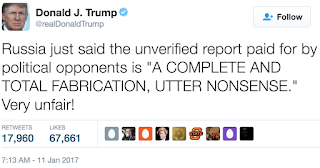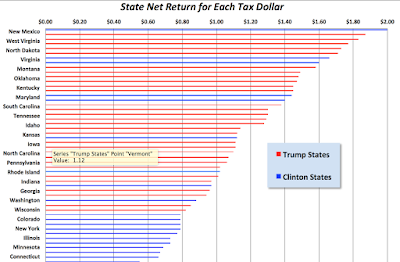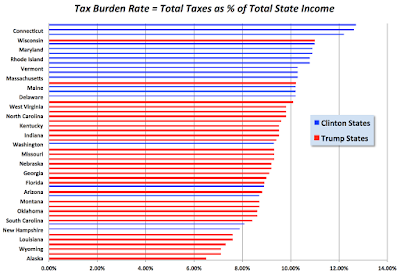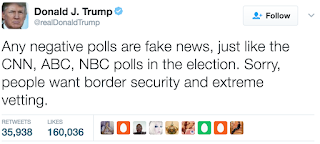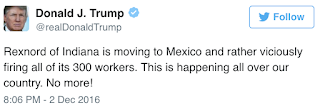The Tweet: The conservative movement sold its soul to the Trump Presidency. Together, Trump and Steve Bannon stand in abject opposition to everything conservatism once stood for. Each day conservatives fail to confront the President brings them a day closer to the complete undoing of the conservative movement.
At the opening of the Conservative Political Action Conference last week, Dan Schneider, the Executive Director of the American Conservative Union (ACU)--the ancestral home of the conservative movement--railed against the growing influence of the alt-right within their ranks. They were, he insisted "hate-filled, left-wing fascists... They are antisemites. They are racists. They are sexists. They hate the Constitution. They hate free markets. They hate pluralism. They hate everything and despise everything we believe in."
It was startling to hear Schneider raise the specter of fascism in a public forum. While it is a term thrown around frequently on the left these days, on that end of the political spectrum fascism is generally viewed as a hate-filled, right-wing movement. No one, it seems, wants to own fascism, but it is clearly on many people's mind.
Commenting from London last week on the rise of populist insurgents in the United States and Europe, Philip Stephens of the Financial Times recalled a review of Adolph Hitler's Mein Kampf written by George Orwell in 1940, reflecting on the urge at the time to resist calling fascism what it was: "The obvious intention of the translator's preface and notes is to tone down the book's ferocity and present Hitler in as kindly a light as possible. At that date [1939] Hitler was still respectable. He had crushed the German Labour movement, and for that the property-owning classes were willing to forgive him almost anything. Both Left and Right concurred in the very shallow notion that National Socialism was merely a version of Conservatism."
Orwell's words are mirrored in the struggles in the conservative movement to respond to the rise of Trump. During the presidential campaign, the Board of the ACU was split between those who successfully argued that the group must endorse him because he was the Republican nominee, and those who were repelled by both Trump and the alt-right fringe he brought with him. Last week, the Board finally took a stand, deciding to deny a platform to alt-right notables Milo Yiannopoulos and Richard Spencer.
But it was too little, too late. The actions by the Board resolved little. The elephant in the room was Steve Bannon, Donald Trump's chief strategist, who had been excluded from CPAC in previous years on account of his bomb-throwing affiliation with the alt-right. Schneider did not specifically mention Bannon by name in his jeremiad against the alt-right influences permeating the conservative movement, but Bannon's presence at CPAC as the power behind the throne in the new Republican administration was not lost on anyone.
Steve Bannon firmly rejects the notion that he is a white nationalist, claiming instead the more politically correct monicker of "economic nationalist." But truth be told, unlike his boss, Bannon is not a guy who seems to care very much what label people assign to him. As much as he might play it down, Bannon was not kidding when, in 2013, he told a reporter that he is a Leninist. "Lenin wanted to destroy the state," Bannon reportedly said at the time, "and that’s my goal, too. I want to bring everything crashing down, and destroy all of today’s establishment." Bannon has barely moderated his taste for hyperbole since achieving the apex of power. This week, he declared at CPAC that among his goals is "the deconstruction of the administrative state."
Bannon is opaque about what his notion of economic nationalism entails, or what he imagines the U.S. economy might look like after that deconstruction is complete. But it has to be about more than tax rates, tariffs and deregulation; that's pretty banal stuff. That agenda would not require a wholesale attack on the media and the judiciary, and would place him foursquare in the mainstream of the Republican Party, which he deeply disdains. Jobs have long been the currency of politics--and no one in memory made them as integral to their campaign as did Donald Trump--but Bannon has to have more in mind than jawboning a few American transnational corporations to build a factory or two in eastern Kentucky or the upper peninsula of Michigan.
Bannon is an obscurantist--that is to say that he talks and acts in a manner to deliberately obscure what his intentions are--and then he bemoans the "smear campaigns" by the media who he claims do not accurately portray him or his intentions. Then he carries those smears as a badge of honor, adding to the dark, enigmatic persona that he appears to cultivate.
Listening to Bannon's talks and reading interviews from over the years, one can glean a number of themes woven into the tapestry of his world view. These are his words, his own framing of his world view. At the Liberty Restoration Foundation in 2011, he discussed the pall that the nation's staggering unfunded financial burdens cast on our future, and which our political system has proven itself incapable of tackling. Appearing before a symposium organized by conservative critics of Pope Francis in the Vatican in 2014, he suggested that modern capitalism had been undone by greed--that it has lost its grounding in Judeo-Christian morality that once tempered its worst instincts--and by crony capitalism that enabled elites in government and business to profit at the expense of the rest of society.
The economic decay of the west, as symbolized by this over-leveraging and degradation of capitalism--challenges for which, it is important to note, he has actually offers few apparent solutions beyond nationalist rhetoric--combines with his view of the civilizational war between the "Judeo-Christian West" and Islam to produce the dark vision of America and the world evident in Donald Trump's inaugural address. As Bannon explained at the Vatican, "We’re at the very beginning stages of a very brutal and bloody conflict... against this new barbarity... that will completely eradicate everything that we’ve been bequeathed over the last 2,000, 2,500 years."
And then there was Bannon's interview with Donald Trump on Breitbart News in 2015, early on in his cultivation of the President. In that discussion, Bannon expressed his opposition to legal and illegal immigration alike, his view of American Muslims as a fifth column, posing an existential threat to the nation, and the problems of Asian ownership and influence in the Silicon Valley. When Trump demurred mildly, Bannon pushed back. “A country is," he argued to Trump, reflecting his ethno-nationalist argument that the United States and its culture are being undermined by the forces of globalism and multiculturalism, "more than an economy. We’re a civic society.”
Bannon has found in Trump a means to rescue a nation that is in economic decline, has drifted away from its moral grounding, and is under siege from a hostile, barbarian civilization. Taken together, Bannon's radical, millennialist vision and infatuation with power, and Trump's "I alone can fix it" infatuation with himself, stand in abject opposition to long-standing conservative principles. Dan Schneider's words may have resonated with those movement conservatives who have not been seduced by the lure of a Republican presidency, but it was way too little, too way late. The conservative movement, or what was left of it, had been subsumed under the Trump banner.
There was Steve Bannon, sharing the CPAC stage with Reince Priebus--Trump's dutiful factotum, who has no grasp of the historical moment. Bannon described the new political order that they were bringing together and warned the audience of the battles that lay ahead. Then he issued his call to arms in the ethno-nationalist language of the populist movements sweeping across Europe: "We are a nation with a culture and a — and a reason for being. And I think that is what unites us."
Artwork by Jay Duret. Follow him on Twitter @jayduret or Instagram at @joefaces.
At the opening of the Conservative Political Action Conference last week, Dan Schneider, the Executive Director of the American Conservative Union (ACU)--the ancestral home of the conservative movement--railed against the growing influence of the alt-right within their ranks. They were, he insisted "hate-filled, left-wing fascists... They are antisemites. They are racists. They are sexists. They hate the Constitution. They hate free markets. They hate pluralism. They hate everything and despise everything we believe in."
It was startling to hear Schneider raise the specter of fascism in a public forum. While it is a term thrown around frequently on the left these days, on that end of the political spectrum fascism is generally viewed as a hate-filled, right-wing movement. No one, it seems, wants to own fascism, but it is clearly on many people's mind.
Commenting from London last week on the rise of populist insurgents in the United States and Europe, Philip Stephens of the Financial Times recalled a review of Adolph Hitler's Mein Kampf written by George Orwell in 1940, reflecting on the urge at the time to resist calling fascism what it was: "The obvious intention of the translator's preface and notes is to tone down the book's ferocity and present Hitler in as kindly a light as possible. At that date [1939] Hitler was still respectable. He had crushed the German Labour movement, and for that the property-owning classes were willing to forgive him almost anything. Both Left and Right concurred in the very shallow notion that National Socialism was merely a version of Conservatism."
Orwell's words are mirrored in the struggles in the conservative movement to respond to the rise of Trump. During the presidential campaign, the Board of the ACU was split between those who successfully argued that the group must endorse him because he was the Republican nominee, and those who were repelled by both Trump and the alt-right fringe he brought with him. Last week, the Board finally took a stand, deciding to deny a platform to alt-right notables Milo Yiannopoulos and Richard Spencer.
But it was too little, too late. The actions by the Board resolved little. The elephant in the room was Steve Bannon, Donald Trump's chief strategist, who had been excluded from CPAC in previous years on account of his bomb-throwing affiliation with the alt-right. Schneider did not specifically mention Bannon by name in his jeremiad against the alt-right influences permeating the conservative movement, but Bannon's presence at CPAC as the power behind the throne in the new Republican administration was not lost on anyone.
Steve Bannon firmly rejects the notion that he is a white nationalist, claiming instead the more politically correct monicker of "economic nationalist." But truth be told, unlike his boss, Bannon is not a guy who seems to care very much what label people assign to him. As much as he might play it down, Bannon was not kidding when, in 2013, he told a reporter that he is a Leninist. "Lenin wanted to destroy the state," Bannon reportedly said at the time, "and that’s my goal, too. I want to bring everything crashing down, and destroy all of today’s establishment." Bannon has barely moderated his taste for hyperbole since achieving the apex of power. This week, he declared at CPAC that among his goals is "the deconstruction of the administrative state."
Bannon is opaque about what his notion of economic nationalism entails, or what he imagines the U.S. economy might look like after that deconstruction is complete. But it has to be about more than tax rates, tariffs and deregulation; that's pretty banal stuff. That agenda would not require a wholesale attack on the media and the judiciary, and would place him foursquare in the mainstream of the Republican Party, which he deeply disdains. Jobs have long been the currency of politics--and no one in memory made them as integral to their campaign as did Donald Trump--but Bannon has to have more in mind than jawboning a few American transnational corporations to build a factory or two in eastern Kentucky or the upper peninsula of Michigan.
Listening to Bannon's talks and reading interviews from over the years, one can glean a number of themes woven into the tapestry of his world view. These are his words, his own framing of his world view. At the Liberty Restoration Foundation in 2011, he discussed the pall that the nation's staggering unfunded financial burdens cast on our future, and which our political system has proven itself incapable of tackling. Appearing before a symposium organized by conservative critics of Pope Francis in the Vatican in 2014, he suggested that modern capitalism had been undone by greed--that it has lost its grounding in Judeo-Christian morality that once tempered its worst instincts--and by crony capitalism that enabled elites in government and business to profit at the expense of the rest of society.
The economic decay of the west, as symbolized by this over-leveraging and degradation of capitalism--challenges for which, it is important to note, he has actually offers few apparent solutions beyond nationalist rhetoric--combines with his view of the civilizational war between the "Judeo-Christian West" and Islam to produce the dark vision of America and the world evident in Donald Trump's inaugural address. As Bannon explained at the Vatican, "We’re at the very beginning stages of a very brutal and bloody conflict... against this new barbarity... that will completely eradicate everything that we’ve been bequeathed over the last 2,000, 2,500 years."
And then there was Bannon's interview with Donald Trump on Breitbart News in 2015, early on in his cultivation of the President. In that discussion, Bannon expressed his opposition to legal and illegal immigration alike, his view of American Muslims as a fifth column, posing an existential threat to the nation, and the problems of Asian ownership and influence in the Silicon Valley. When Trump demurred mildly, Bannon pushed back. “A country is," he argued to Trump, reflecting his ethno-nationalist argument that the United States and its culture are being undermined by the forces of globalism and multiculturalism, "more than an economy. We’re a civic society.”
Bannon has found in Trump a means to rescue a nation that is in economic decline, has drifted away from its moral grounding, and is under siege from a hostile, barbarian civilization. Taken together, Bannon's radical, millennialist vision and infatuation with power, and Trump's "I alone can fix it" infatuation with himself, stand in abject opposition to long-standing conservative principles. Dan Schneider's words may have resonated with those movement conservatives who have not been seduced by the lure of a Republican presidency, but it was way too little, too way late. The conservative movement, or what was left of it, had been subsumed under the Trump banner.
There was Steve Bannon, sharing the CPAC stage with Reince Priebus--Trump's dutiful factotum, who has no grasp of the historical moment. Bannon described the new political order that they were bringing together and warned the audience of the battles that lay ahead. Then he issued his call to arms in the ethno-nationalist language of the populist movements sweeping across Europe: "We are a nation with a culture and a — and a reason for being. And I think that is what unites us."
Artwork by Jay Duret. Follow him on Twitter @jayduret or Instagram at @joefaces.




